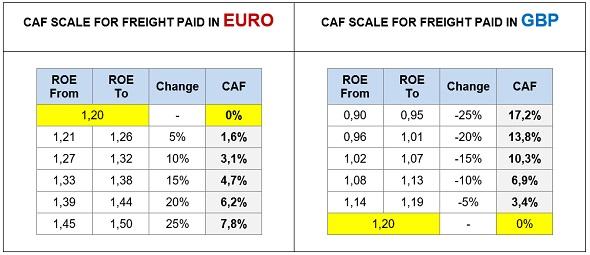Transporting goods across the globe is a complex and intricate process that involves numerous factors, one of which is the Currency Adjustment Factor (CAF). This crucial component of logistics and shipping plays a significant role in determining freight rates and ensuring fair pricing in the ever-changing world of international trade. In this article, we will explore the ins and outs of CAF, shedding light on its impact on the transportation industry and how it affects businesses worldwide.
Understanding the Impact of Currency Adjustment Factor (CAF) on Logistics Costs
Currency Adjustment Factor (CAF) is a crucial component in determining logistics costs for transporting goods across borders. It refers to the fluctuation in currency exchange rates that impacts the pricing of international freight services. The CAF is applied to offset the risks associated with currency fluctuations and ensure that logistics providers can maintain profitability in a volatile market.
Understanding the impact of CAF on logistics costs is essential for businesses operating in the global marketplace. By keeping track of currency adjustments and factoring them into transportation budgets, companies can effectively manage their supply chain expenses. Factors such as economic stability, inflation rates, and geopolitical events can all influence currency values, leading to fluctuations that can affect shipping costs. By staying informed and adapting to these changes, businesses can mitigate the impact of CAF on their logistics operations and maintain competitive pricing in the international market.

Optimizing Transport Strategies in Response to CAF Fluctuations
Currency Adjustment Factor (CAF) fluctuations can have a significant impact on transport strategies, especially in the shipping industry. As CAF rates change, it is crucial for logistics companies to adapt and optimize their transport strategies to minimize costs and ensure efficient operations.
One way to optimize transport strategies in response to CAF fluctuations is to diversify shipping routes and carriers. By working with multiple carriers and exploring different routes, companies can mitigate the impact of CAF changes and take advantage of more favorable rates. Additionally, leveraging technology and data analytics can help companies identify patterns in CAF fluctuations and make informed decisions to optimize their transport strategies accordingly.

Maximizing Shipping Efficiency through CAF Management Strategies
When it comes to maximizing shipping efficiency, understanding and effectively managing Currency Adjustment Factors (CAFs) is crucial. CAFs are charges imposed by shipping lines to account for fluctuations in exchange rates and fuel costs. By implementing strategic CAF management strategies, companies can mitigate the impact of these variables on shipping costs and ensure a smooth and cost-effective supply chain.
One key strategy for optimizing CAF management is to leverage technology for real-time exchange rate monitoring. By tracking currency fluctuations and adjusting shipping contracts accordingly, companies can avoid unexpected cost increases and keep their shipping operations running smoothly. Additionally, negotiating fixed CAFs with carriers can provide more predictability and stability in shipping costs, allowing businesses to better plan and budget for their logistics expenses.

Key Considerations for Navigating CAF Variability in Global Supply Chains
When navigating the variability of Currency Adjustment Factors (CAFs) in global supply chains, there are several key considerations that can help businesses maintain cost-effectiveness and efficiency. One important factor to keep in mind is the volatility of exchange rates, which can directly impact CAFs and overall shipping costs. Monitoring exchange rate fluctuations and adapting shipping strategies accordingly can help mitigate the impact of CAF variability.
Another crucial consideration is the negotiation of freight contracts with transparent CAF clauses. Clear agreements that specify how CAFs will be calculated and adjusted can provide clarity and predictability for both the shipper and carrier. Additionally, leveraging technology and data analytics can help businesses analyze CAF trends, optimize shipping routes, and make informed decisions to navigate CAF variability in global supply chains.
To Wrap It Up
In conclusion, understanding the Currency Adjustment Factor (CAF) is crucial for successful logistics, transport, and shipping operations. By staying informed and proactive in monitoring currency fluctuations, businesses can better manage their costs and streamline their supply chain processes. With the right strategies in place, companies can navigate the complexities of global commerce with ease. So, embrace the CAF and let it be your guiding compass in the dynamic world of logistics and transportation. Happy shipping!
